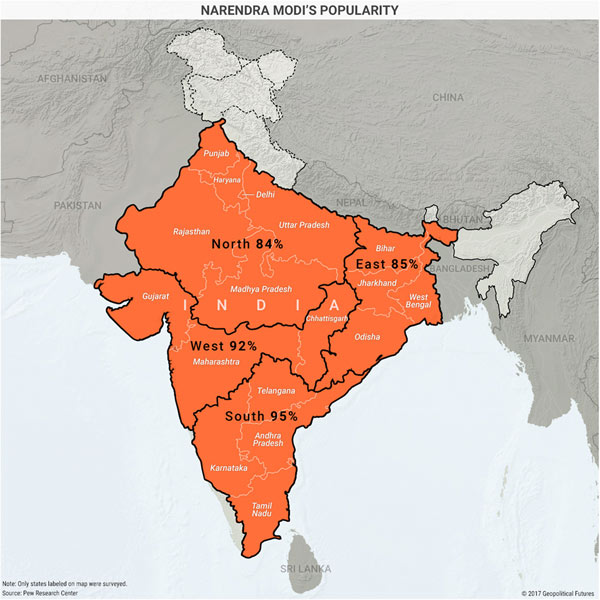India's Brewing Nationalist Movement
Politics / India Nov 22, 2017 - 03:18 PM GMTBy: John_Mauldin
Indian Prime Minister Narendra Modi’s revolutionary vision for his country’s future bears little resemblance to its present. Yet polls suggest that a strong majority of Indian society may have bought into that vision.
According to a Pew survey released this week, 88 percent of Indians hold a favorable view of Modi, and 83 percent are satisfied with the state of the economy. Most notably, 70 percent said they were satisfied with the direction their country is moving in.
Just 29 percent felt this way in 2013—the year before Modi took office—which means there has been a seismic shift in public sentiment in India.

Source: Geopolitical Futures (click to enlarge)
Modi’s vision can be boiled down to three elements:
- strengthening the central government
- strengthening the military
- strengthening Indian society
The third element is in many ways the most daunting. India is a vast collection of religions, ethnicities, and languages. And Modi doesn’t view this diversity as an advantage. He is a Hindu nationalist, and he wants India to be a nation-state with a uniquely Hindu identity.
Modi’s position is similar to a number of nationalist movements in other countries whose popularity has increased in recent years. The problem, however, is that the diversity of Indian society is orders of magnitude greater than that of countries like Spain, for example, or even China.
This is what makes the Pew survey so arresting. It would be one thing if a large majority of Indians were simply happy with Modi’s economic policies and more assertive foreign policy. But the survey says most Indians are satisfied with the direction in which Modi is taking the country.
If (and it’s a big if) the survey results mean the vast majority of Indians support Modi’s articulation of Hindu nationalism, then maybe a new Indian identity is emerging at the local level.
Perhaps Modi is not driving India toward a more Hindu nationalist direction—perhaps India is becoming more Hindu nationalist, and Modi’s election and subsequent successes are an expression of that identity taking root.
If an Indian government, whether led by Modi or someone else, finds itself in charge of a unified India, it would be able to marshal India’s vast resources more efficiently than ever before.
Then, India would no longer be the poor, decentralized, inefficient country it is today. With a unifying identity, India could become a powerhouse whose rise could have massive consequences for the balance of power—not just in the Indo-Pacific but around the world.
Grab George Friedman's Exclusive eBook, The World Explained in Maps
The World Explained in Maps reveals the panorama of geopolitical landscapes influencing today's governments and global financial systems. Don't miss this chance to prepare for the year ahead with the straight facts about every major country’s and region's current geopolitical climate. You won't find political rhetoric or media hype here.
The World Explained in Maps is an essential guide for every investor as 2017 takes shape. Get your copy now—free!
John Mauldin Archive |
© 2005-2022 http://www.MarketOracle.co.uk - The Market Oracle is a FREE Daily Financial Markets Analysis & Forecasting online publication.



